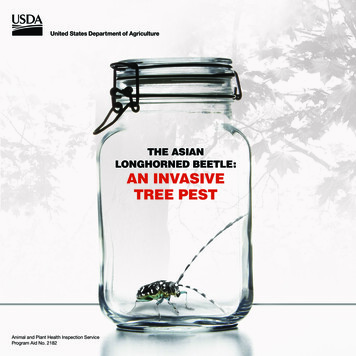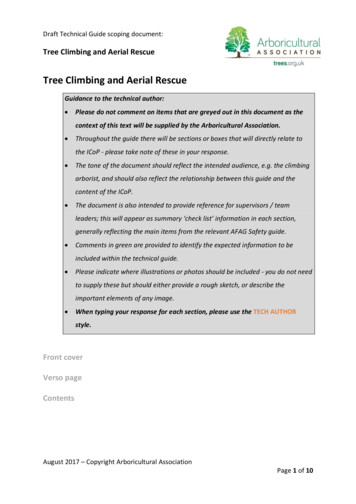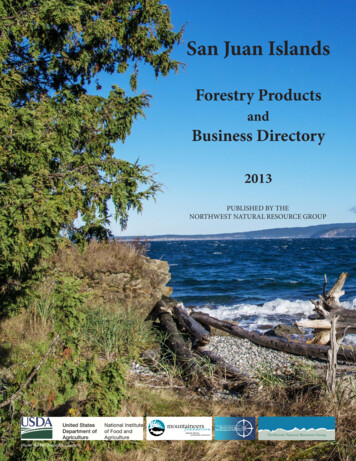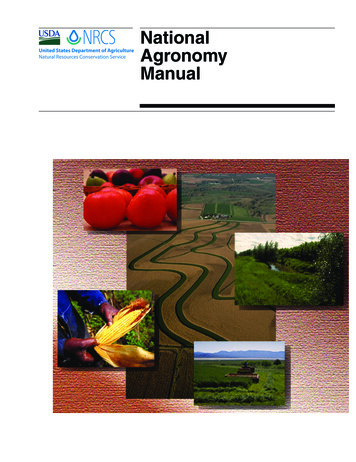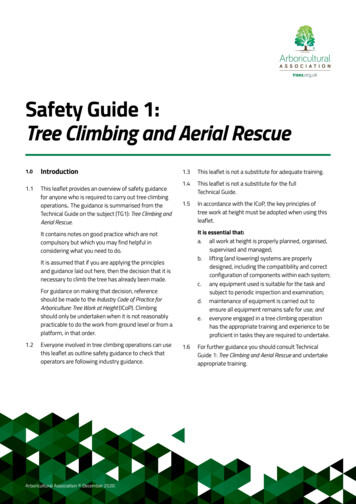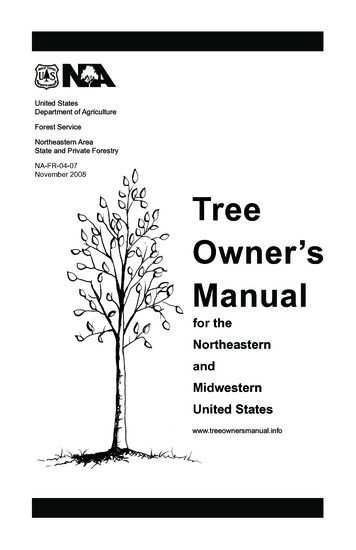
Transcription
United StatesDepartment of AgricultureForest ServiceNortheastern AreaState and Private ForestryNA-FR-04-07November 2008TreeTreeOwner’sManualfor theNortheasternandMidwesternUnited Stateswww.treeownersmanual.info
Tree Owner's Manualfor the Northeastern andMidwestern United StatesAuthors:Jill R. Johnson, Forest ServiceGary R. Johnson, University of MinnesotaMaureen H. McDonough, Michigan StateUniversityLisa L. Burban, Forest ServiceJanette K. Monear, Tree TrustIllustrator:Jennifer SalvesonTechnical Reviewers:Katie Armstrong, Forest ServiceBert Cregg, Michigan State UniversityPaul Dykema, City of Lansing, MIDennis Fallon, Xcel EnergyDanielle Fitzko, Vermont Dept. of Forests,Parks, and RecreationJustine Gartner, Missouri Dept. ofConservationSharon Lilly, International Society ofArboriculturePam Louks, Indiana Dept. of NaturalResourcesRita McKenzie, Purdue UniversityJill Pokorny, Forest ServiceBob Ricard, University of ConnecticutTom Wawra, Bachman’s LandscapingLes Werner, University of WisconsinStevens PointPaul Wierzbicki, Tree TrustRon Zillmer, Mid-State Technical CollegeTable of ContentsImportant Precautions . 1Model Information and Parts Diagram . 2Deciduous Model. .2Evergreen Model. 3Packaging . 3Roots . 3Trunk and Branches . 3Pre-Installation (Preparing to Plant) . 4Materials . 4Instructions . 4Installation (Planting) . 6Materials . 6Instructions . 6Maintenance Schedule. 12Maintenance Instructions . 13Watering. 13Installing a Trunk Guard . 14Preventing and CorrectingEncircling Roots . 15Mulching . 16Fertilizing . 16Checking Tree Health. 17Checking Tree Safety . 17Pruning . 18Protecting Trees from ConstructionDamage . 24Record of Tree Types and Locations . 26Service and Repair. 28How to Hire an Arborist . 28Record of Service. 29Troubleshooting . 30Other Sources of Help. 31In the Event of an Emergency . 32Removal and Disposal . 33Whole Tree. 33Trimmings . 33Leaves . 33Buying a New Tree. 34Decide on the type of tree. . 34Select a high quality tree at thenursery. . 35Additional Sources of Information. 35Transporting Your Tree. Back coverStoring Your Tree Until Planting.Back coverNortheastern AreaState and Private ForestryForest ServiceU.S. Department of Agriculture11 Campus Blvd., Suite 200Newtown Square, PA 19073NA-FR-04-07November 2008www.na.fs.fed.usThe use of trade or firm names in thispublication is for reader information anddoes not imply endorsement of the U.S.Department of Agriculture of any product orservice.
IMPortant PrecautIonsWARNING: To reduce the risk of personal injury or permanent damage to yourtree, read and follow these important precautions: Do not dig until you are sure there are no buried utilities. Call the freeutility marking service at 1-888-258-0808 (p. 5). Never prune trees or branches that are within 10 feet of utility lines;contact your local utility company. Keep lawn mowers and weed whips away from the base of your tree. Do not tie string, ribbon, wire, or pet leashes around the trunk orbranches. Do not allow construction activities (digging, repaving, grading, building)within the Protected Root Zone (p. 24). Do not top your tree (p. 23). When hiring an arborist, select someone who has general liabilityinsurance of at least 1 million per occurrence and 2 million aggregate(p. 28). Check with your city or town to see if there are laws regarding plantingand pruning. If you cannot prune your tree with both feet on the ground, hire anarborist (p. 28). Do not let children climb trees that have branches within 25 feet of apower line. Do not nail or screw anything into your tree.These symbols are used throughout this manual: Potential for personal injury or legal issues! Potential for permanent damage to tree Save this manual for future reference. Tree Owner’s Manual1
Model InforMatIon and Parts dIagraMDeciduous Model(loses leaves in the autumn)Central Leader*(one main branch that extends straightup from the es)]Note:Flowers and fruitvary by tree type inshape and time ofappearanceGroundSurfaceDriplineGraft Union*Root CollarRoots*Not present on all ne on the ground underthe outermost edge of atree's crown)
Model Information and Parts DiagramEvergreen Model(keeps green leaves allyear long)CrownDripline(line on the ground underthe outermost edge of atree's ur tree has been packaged in one ofthe following ways:Balled and burlappedTrunk andBranchesContainerizedTwine aroundbranchesBare root(no soil or packaging)Tag(s)Trunk wrapTree Owner’s Manual3
Pre-InstallatIon (PreParIng to Plant)Materials Tape measure PhoneInstructionsStep 1: Check above ground.!Your tree will grow.Do not plant your tree where it will interfere with buildings, overhead utility lines,pavement, or intersection sightlines as it gets bigger.Make sure your planting spot is at least. . . 3 feet from pavement or fencing on all sides 15 feet from buildings or other trees 25 feet from overhead electric wires, if your tree will growtaller than 30 feet.If your tree will grow taller than 30 feet, do not plant it within 25 feet of overheadelectric wires.Trees over 30 feet 25 feet from wires 15 feet between trees 15 feet from buildings 3 feet from pavement4www.treeownersmanual.info
Pre-Installation (Preparing to Plant)Step 2: Check belowground.It’s the law to call (in most states).Will Your Tree Becomea "Public Tree," Underthe Control of YourCity or Town?Shocks can be deadly.Public trees are those locatedAt least 72 hours in advance ofplanting, call the undergroundutility locating service in your areato be sure that there are no buriedutilities where you want to plant.Most services will mark utilities (e.g.,electric, cable, gas) for free.on municipal property or withinthe road right-of-way (ROW)–regardless of who planted thetree.The ROW is an extension of yourcity’s or town’s control beyondCall before you dig!1-888-258-0808 the street edge, oftentimesreaching 10 feet or more beyondthe pavement.Trees located within the ROWare under the jurisdiction of themunicipality.In these cases, state or locallaws may dictate the type andStep 3: Check laws.Some government agencies havelaws governing tree planting, care,and removal. Check with your townor municipality to be sure that you arecomplying with these regulations andlandscape ordinances.location of trees that can beplanted in the ROW. Checkwith your city or town regardingordinances or policies pertainingto public trees.Tree Owner’s Manual5
InstallatIon (PlantIng)*How to MoveYour TreeMaterials Tape measure or yard stick Metal skewer, coat hanger,stout wire, or pointedscrewdriverCarry your tree by its rootpackage (ball or container)—notthe trunk! Steady it by holding thelowest part of the trunk. ShovelLarge containerized trees maybe tipped onto the bottom edgeand rolled. Sharp knife or scissors Hand pruner—bypass type(p. 19) 5 gallons of water 4-5 cubic feet of mulch (onewheelbarrow load or twolarge bags) Large-gauge wire cutter ifballed and burlappedFor balled-and-burlapped trees,you may fifindnd it easiest to placetarps or ropes under the ball asa sling.A dolly or other cart may also beused.!6Protect the trunk.Even a small wound ona young tree can causepermanent damage.www.treeownersmanual.info Hand saw if containerizedand the main root systemis more than 1 inch belowthe soil surface (Step 4). Aninexpensive folding pruningsaw works well, but any sawwould work.Instructions!If you have NOT yet read thesection on Pre-Installation(Preparing to Plant), do so now.!Do not dig until Step 6.*Hargrave, R.; Johnson, G.; Zins, M. 2002.Planting trees and shrubs for longterm health. St. Paul, MN: University ofMinnesota Extension Service. 12 p.
Installation (Planting) - InstructionsStep 1. Move the tree.! Young trees are not 2 by 4’s.Do not lift or carry your tree by its trunk (unless bare root). See the sidebar on Howto Move Your Tree.Step 2. Remove trunk and branch packaging.Remove trunk wrap, twine around the branches, and labels. Leave anyroot packaging in place for now.Step 3. Prune critical branches and no others!Prune only branches that are broken or dead. You may also removecompeting leaders, if present. Most trees should have one central leader(p. 2-3). If there are two or more leaders, choose which one you want toremain and remove the other(s).!Minimize pruning at the time of planting!Trees need as many leaves as possible to recover from transplant shock (leavesproduce the tree’s food).!Do not prune oaks in the spring or early summer if you live in an area with oakwilt (see map, p. 21)!See “Pruning” p. 18.Two leadersprunehere12DeadBrokenprunehereprunehereTree Owner’s Manual7
Installation (Planting) - InstructionsStep 4. Find the main root system, and remove excesssoil.Remove soil from the top of the root ball until the top of the main root systemis exposed. There should be several roots at least as big around as a pencilextending in opposite directions from the trunk. You may have to remove 2-4inches of soil before finding the main roots.TIP: Probe the soil ball with a wire, kabob skewer, orscrewdriver to find the main root system and estimate howmuch soil to remove. If the roots are located more than 4inches deep, return the tree to the place of purchase.Bare root trees: There is no soil or root packaging to remove.Balled-and-burlapped trees: Remove the top of the root ball packaging. Cutany twine from around the trunk taking care not to nick the bark. Then bend thewire basket back off the top of the ball. Remove soil from the top of the root balluntil the main root system is found. You may have to cut some of the wire. Leavethe rest of the wire basket in place until the tree is put in the ground.Containerized trees: Remove the entire container. Pull or cut the soil off the topof the root ball until the main root system is found.TIP: A saw works well to remove the top layer of soil. Be careful not to cut intothe trunk.8www.treeownersmanual.info
Installation (Planting) - InstructionsStep 5. Remove problem roots.A. Remove all small roots above the main root system with a hand pruner.B. Examine the main root system for roots that extend out but then turn tothe side or back towards the trunk. Prune these roots at the point wherethey turn.prune hereStep 6. Determine how deep and wide to dig.A. Measure the height of the remaining root ball. This is exactly how deepyou should dig the hole.B. Measure the approximate width of the root ball or root system. Multiplythis by 2, or if your soil is hard (clay or compacted), by at least 3. This ishow wide you should dig the hole.Bare rootContainerized(roots spread out flaton the ground)Balled and burlapped(excess soil removed)(excess soil removed)hhhh depth of planting holewWidth of hole should be 2-3 times thewidth of the root ballTree Owner’s Manual9
Installation (Planting) - InstructionsStep 7. Dig a hole.!Do not put a 100 tree in a 10 hole. The dimensions of the hole are veryimportant in determining the survival of your tree. Dig the hole ONLY as deep as theroot system (NO deeper!).HOLE DEPTH height of root ball (h)HOLE WIDTH width of root ball (w) x 2 or 3whStep 8. Put the tree in the hole.If the tree has a heavy root ball, slide it into the hole, and straighten the trunk.Step 9. For balled-and-burlapped trees, remove root ballpackaging.Balled-and-burlapped trees: Without loosening the root ball, cut, peel back, andremove as much of the wire basket and burlap as possible (at least the top third).!10A root ball should remain a root ball. If it starts to fall apart as you take off thewire and burlap, backfill the hole with enough soil to stabilize it. Then carefullyremove the wire and burlap, and backfill as you go to keep the root ball intact.www.treeownersmanual.info
Installation (Planting) - InstructionsStep 10. Backfill withthe same soil.Make sure the trunk is straight. Putthe original soil back in the hole,breaking up large clods, and workingit in with your hands or a shovel.Step 11. Water.Water the root ball and entirebackfilled area.Step 12. Mulch.Put a 2-4 inch layer of mulch over thebackfilled area. Pull mulch away fromthe trunk so that none touches thebark.!To Stake orNot to StakeSome trees need to be stakedto remain standing straight intheir new planting site. Stakeonly if the root ball is unstableor the trunk is bending. Usewide nylon, canvas straps,or nylon stockings wrappedaround one side of the trunk.The tree should not be tiedtightly.If the root ballis unstable,use 1-3 stakesattached LOWon the trunk.Mulch becomes soil.There should never be more than 4inches of mulch over the roots. Toomuch can prevent the roots fromgetting necessary oxygen.BackfillIf the trunk isbending, use 1stake attachedHIGHER (at least6 inches belowthe firstfirst set ofbranches).WaterMulchNo!!Less than 4 inchesdeep, never touchingthe trunkRemove stakes after1-2 years.Tree Owner’s Manual11
MaIntenance scheduleFollow this maintenance schedule for the life of your tree. Detailed instructionsare on the pages indicated in parentheses.TimelineTypeof this maintenance schedule for the life of your tree. Detailed instructionsFollowAt plantingYearsYearsAfterCareare on the pages indicated in parentheses.1 to 34 to 1010 yearsWater(p. 13)5 gallonsCorrect amount iscritical fromspring throughautumnMulch(p. 16)2-4 inches deep,not against trunkCheck and adjustlevel in springAs neededCheck in spring andautumnOnly ifneededCheck in spring andautumn. Removeafter 1-2 years.N/AClean root collarevery yearCheck beforeplanting (p. 9)N/ACheck Health(p. 17, 35)Select a healthytree (p. 35)Inspect leaves,branches, crownand trunk every year(p. 17)Check Safety(p. 17)N/AInspect in summer,winter, and afterstorms (p. 17)Prune*(p. 7, 18-23)Prune only criticalbranches or toeliminate extraleaders(p. 7)Prune lightly in Year2 or 3 (p. 18-23)Protect Trunk(p. 14)Stake(p. 11)Clean RootCollar(p. 15)Check forEncirclingRoots(p. 9, 15)As neededfromspringthroughautumnN/AN/AN/ACheckevery 4-5years(p. 15)Every 3yearsFruit treesevery 1-3years,deciduousshade treesevery 5 years,evergreensonly as needed*For some tree types, pruning or removal during spring and summer requires special care toprevent disease transmisssion. See p. 20 for details.N/A—not applicable12www.treeownersmanual.info
MaIntenance InstructIonsWatering*An important factor in tree survival is providing the right amount of water. Thefirst 3 years are most critical, but pay attention to watering needs throughout thetree’s life.How often and howmuch?Frequency depends on soildrainage. Soils that drain quicklywill require more frequent wateringthan those that drain slowly. Todetermine your soil’s drainagerate, see p. 34. The best way toknow how often and how much towater is to check the soil moistureat 6 inches below the surface.Water when dry.First 3 years after planting: If thesoil is dry, provide about 1-1/2gallons of water per diameter inchof the trunk.All other years: Because soil typeand weather conditions influencethe demand for water, irrigationschedules and amounts vary.!Tree roots need oxygen.Soil saturated with waterfor more than 24 hours canprevent roots from gettingoxygen. Therefore, wateringtoo much is as dangerousas watering too little (and isharder to correct).First 3 years after planting: Check every other day infast-draining soils, weeklyin slow-draining soilsWater within thedriplineAll other years: CheckweeklyWaterwithin thedripline or,for largetrees, atthe baseand at thedriplineWhere? Water the area within the dripline.For large trees, focus watering on the areawithin 6 feet of the trunk and at the dripline.When? Start checking soil moisture andwatering when necessary in early spring,and continue until the soil freezes.*Gilman, E. 1997. Trees for urban and suburban landscapes. Albany, NY: Delmar Publishers. 662 p.Tree Owner’s Manual13
Maintenance InstructionsInstalling a Trunk GuardTrunk ProtectionYoung deciduous trees have thin bark that can easily be damaged by animalsand equipment (most commonly string trimmers and lawn mowers). Mulch doesa great job of keeping grass (and therefore grass-cutting equipment) away fromtrunks, but rodents such as rabbits and mice like to chew on young bark (usuallylow on the trunk). Deer also scrape tree trunks with their antlers.To prevent long-term damage associated with trunk wounding, install plastictubing or hardware cloth (stiff wire fencing with 1/4-1/2 inch mesh squares)around the trunk. The tube should be big enough around to allow 1-4 inches ofspace between it and the trunk. It should be 1-3 feet tall (extending above theanticipated snow depth) for small rodents and as tall as possible for deer.How? Wrap the tube around the trunk, taking care not to scratch the bark. Usea few pieces of wire to keep the tube closed. Push the tube into the ground ormulch less than an inch. Attach it to one or two stakes if necessary.When? At a minimum, the trunk should be protected during the winter months(apply early in the autumn to prevent deer scraping). Protection can be appliedanytime and left on all year round, as long as it does not touch the bark.!14Your tree will grow.As the tree grows, the tube will need to be enlarged and eventually removed.www.treeownersmanual.info
Maintenance InstructionsPreventing and Correcting Encircling Roots*ProblemHow to PreventRoots that encircle the trunkwill likely cause health or safetyproblems later. Make sure that soilor mulch is never piled against theroot collar.Plant at correct depth (see PlantingSteps 4-7, p. 8-10). Annually cleanthe root collar by removing soil andmulch. CheckyearlyRoot likely to become a problem(when trunk and root meet)How to Monitor andCorrectEvery 4-5 years, check for roots thatencircle the trunk. Use a hand trowelto loosen and remove the soil aroundthe base of the tree until the first set ofroots is found.Expose the root collarProblem root already touching the trunkTIP: Removing soil with a wet-dryvacuum speeds the work withoutharming the roots.Covering the root collar with soil ormulch encourages encircling rootsIf a tree has an encircling root,leave the top of the root exposed,and consult an arborist regardingtreatment. When caught early, thiscan be an inexpensive and effectiveway to save your tree.*Johnson, G.; Fallon, D. 2007. Stem girdling roots: the underground epidemic killing our trees. St. Paul,MN: University of Minnesota.Tree Owner’s Manual15
Maintenance InstructionsMulchingMaintain a ring of mulch around the tree (the wider the better). Organic materialslike wood chips and leaves are best. Wood chips will take longer to break downand, therefore, will not require replacement as often.notagainstbark, 4 inches deepNo! CheckyearlyTIP: Newspaper kills grass.If there is grass in the area that needs to be mulched, put a 5-page layer ofnewspaper over the grass, and then add mulch on top (this will help keep thegrass from growing up through the mulch).!Mulch becomes soil.There should never be more than 4 inches of mulch over the roots. Too muchmulch or soil can prevent oxygen from reaching the roots.FertilizingApply nitrogen fertilizer ONLY if diagnosis by an arborist indicates that it isnecessary.Apply other fertilizers ONLY if a soil test shows that nutrients are lacking.16!Do not overdose.Fertilizer that is not absorbed by the tree has the potential to alter the soil or leachout and pollute groundwater, rivers, ponds, and lakes. Overdosing with fertilizercan harm your tree.!Applying “weed and feed” to your lawn might injure or kill your tree.Some combination weed killers and lawn fertilizers will injure trees. Do not useanything that states it will kill broadleaved weeds (most deciduous trees arebroadleaved). Preemergent herbicides are safe to use near trees.www.treeownersmanual.info
Maintenance InstructionsChecking Tree HealthTree health can be difficult to determine, but checking your tree yearly may helpyou notice problems as they appear.Is the current year’s growth much less than past years’ growth? Fast growthdoes not mean good health, but a dramatic reduction in growth rate may be anindication of poor health.TIP: Look at the branch tips or tree top. Current year’s branches will typically besmaller in diameter and a different color.Also inspect the size, color, and distribution of the leaves. Look at individualleaves as well as the whole crown for differences between branches or sectionsof the crown.Inspect the base of the trunk for damage (e.g., from rodentsor string trimmers).Also inspect the base of the tree to see if there is a flat sideto the trunk.If anything is found, follow the guidance in the Troubleshooting section, p. 30-31.Checking Tree Safety!Healthy trees can fall down.A tree may be green and lush, but that does not guarantee that it is structurally safe.Inspect trees anytime, but especially after storms. Examine the crown, branches,trunk, and area around the roots for these common dangers: Broken, dead, or hanging branchesCracks, fungi, and cavitiesWeak trunk or branch unionsEncircling root compressing thetrunk (a flat-sided trunk at theground level is a good indicator).See illustration above. Recent lean (especially if the soil orgrass has lifted on one side).Branch UnionsWeak—barkgrown inStrong—barkpushed outIf anything is found, or if in doubt, contact an arborist, p. 28.Tree Owner’s Manual17
Maintenance InstructionsPruning*Pruning can be dangerous work. Follow these safety precautions to be sure youare around to enjoy your tree.Electricity flows through branches.Never prune trees or branches that are within 10 feet of utility lines; instead contactyour local utility company.Ladders and trees do not mix.If pruning cannot be done with both feet on the ground, hire an arborist (p. 28).Chainsaws cut limbs.If power equipment is required, hire an arborist (p. 28).The main reasons for pruning trees are safety, health, and esthetics. Pruningcan encourage trees to develop a strong structure and reduce the likelihood ofdamage during severe weather.Pruning for safety involves removing branches that could fall and cause injury orproperty damage, trimming branches that interfere with lines of sight on streets ordriveways, and removing branches that grow into utility lines.Pruning for health involves removing diseased or insect-infested wood, thinningthe crown to increase airflow and reduce some pest problems, and removingcrossing and rubbing branches.Pruning for esthetics involves enhancing the natural form and character of treesor stimulating flower production.*Except where noted, this section has been adapted in part, from: Bedker, P.; O’Brien, J.; Mielke, M.1995. How to prune trees. [Newtown Square], PA: USDA Forest Service Northeastern Area. 30 p.18www.treeownersmanual.info
Maintenance Instructions - PruningWhere to CutSupport the branch with one hand while you make the cut to prevent the barkfrom ripping. If the branch is too large to support, use the three-step method (seedetails below).For the final cut, look for the branch bark ridge and trunk collar. Begin the cut justoutside of the branch bark ridge, and angle down away from the trunk. Stay closeto the trunk collar without cutting into it (see images below).branchbark ridge] Three-step method trunk collar1. Cut one-third of the waythrough the branch on theunder side.2. Go 2-4 inches beyond theundercut to remove thebranch.3. Make the final cut justoutside the branch barkridge and trunk collar.smallbranchlargerbranch finalcutPruning ToolsHand pruner—bypass typeBESTLopper—bypass typeBypass blades cross each otherlike those in a scissors.Hand sawPole saw or prunerPruning saws usually havecurved blades with teeth thatcut when you pull.OKBow saws can be used, but it is often difficult to fit thesaw between branches to make the correct pruning cut.Tree Owner’s Manual19
Maintenance Instructions - PruningHow OftenBeginning 2 years after planting, prune lightly every year or every other year.After 10 years, frequency of pruning depends on the type of tree and amount ofshade the canopy receives.!Do not remove more than 25 percent of the tree’s live branches (and thereforeleaves) at any one time.First 10years10 YearsAfter PlantingFruit treesOnce every 1-2 yearsOnce every 1-3 yearsDeciduous shade treesOnce every 1-2 yearsOnce every 4-7 years*Only as needed**Only as needed**Tree TypeEvergreen trees* Pruning lightly and more frequently is better than pruning heavily and less often.** Evergreen trees usually need pruning only if they are diseased or their branches need tobe raised up from the ground. In either case, prune off the entire branch (p. 19).Removal of the following can be done every year: Broken, dead, or rubbing branches Branches sprouting from the base of the trunk.Time of YearWinter is best time of year to prune because branches are easy to see, diseasescannot be spread, and there is minimal stress to the tree. But for most trees,pruning can be done at any time. Exceptions are trees that are prone to fire blightor oak wilt.Trees susceptible to fire blight include mountain ash, apple, crabapple, hawthorn,pear, flowering quince, and pyracantha. Trees susceptible to oak wilt includemost oaks. To minimize disease infection of these types of trees, follow thepruning guidelines on the next page.20www.treeownersmanual.info
Maintenance Instructions - PruningFIRE BLIGHTRange:Types of trees:All counties in the United Statesmountain-ash, apple, crabapple, hawthorn, pear,flowering quince, pyracanthaPruning guidelines: Avoid pruning from the time that spring flowers emergeuntil leaves drop. If pruning must be done on thesetree types during disease-transmission times, sanitizepruning tools before each branch is pruned. Userubbing alcohol, or household bleach diluted 1 to 9with water. Tools should be immersed in the solution,preferably for 1-2 minutes. Bleach is corrosive tometal, so tools should be thoroughly cleaned with soapand water after each use.OAK WILTRange:See map belowTypes of trees:oaksPruning guidelines: Avoid pruning from early spring through early summer(April, May, and June in the Lakes States). Check withyour plant diagnostic clinic (see page 31 for phonenumbers) to get exact dates for your area. If pruningmust be done on oaks during disease-transmissiontimes, immediately apply wound paint after the cut ismade.!Wound dressings are not necessary in any other case. In fact, they may beharmful.Tree Owner’s Manual21
Maintenance Instructions - PruningPruning Young Trees*Pruning a young tree saves money. Removing small branches is fairly easycompared with waiting until limbs are large, when pruning can be costly anda bigger risk to the tree. Correctly pruning a tree when it’s young will help itdevelop a strong, well-balanced crown. Prune to have the following:A. Branches that are well-attached to the trunkBranches with a branch bark ridge (bark pushed out at the point where thebranch attaches to the trunk) are less likely to break off in wind or heavy ice orsnow. Branches that are less than half the diameter of the trunk are also lesslikely to break off in storms.B. One central leaderMost trees will be strongest if they have one central leader (instead ofmultiple). Unless your tree is an arborvitae or fruit tree, choose one leader tokeep, and prune off the competitors.C. Good spacing between branchesVertical space between branches should eventually be 12 inches for fruit orsmall-statured trees and 18 inches for medium- and large-stature deciduoustrees. Try to space branches equally around the tree.D. Enough clearance between the ground and first branchAs a tree grows taller, branches remain at the same height. Branches locatedlow on the trunk may get in the way of sidewalk paths or lawn mowing as thetree gets bigger. Over time, gradually remove low branches.E. Good crown heightThe crown of a deciduous tree should be at least 60 percent of the total treeheight.!Do not remove more than 25 percent of the tree’s live branches (andtherefore leaves) at any one time.BAWell-attachedbranches have abranch bark ridge.CEAD*Gilman, E. 2002. An illustrated guide to pruning, 2d ed. Albany, NY: Delmar Publishers. 330 p.22www.treeownersmanual.info
Maintenance Instructions - PruningTopping*: (Also called stubbing, heading, tipping, hat-racking, dehorning,or roundover)!Topping is not pruning.Topping is the indiscriminate removalof branch ends. Topping injures andultimately results in early failure ordeath of a tree.TIP: If the end of the branch mustbe
NA-FR-04-07 November 2008 www.na.fs.fed.us . Tree Owner's Manual . for the Northeastern and Midwestern United States . Tree Owner's Manual. Authors: Jill R. Johnson, Forest Service Gary R. Johnson, University of Minnesota Maureen H. McDonough, Michigan State University Lis




